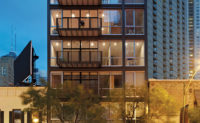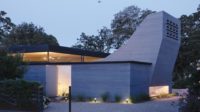Malibu, California
Step through the filigreed entry gates, and you've clearly entered another world. High in the Santa Monica Mountains, a driveway descends amid jungly cacti, pink mink and pincushion protea, and fanciful pagodas fashioned from steel drums, cable spools, and vintage power-line insulators. Then, near the path's end, another feat of salvage comes into view: a glassy house crowned by the wings of a Boeing 747.
Amid rugged mountain peaks with distant ocean views, the 55-acre site was once part of “Sortilegium,” or “The Empire,” the 21-building weekend retreat of Elizabeth (“Beegle”) and Tony Duquette, legendary designer of Hollywood sets, costumes, jewelry, and flamboyantly eclectic interiors. A wizard of inventive repurposing, Tony created opulent chandeliers from plastic juice glasses and, on this rustic Malibu terrain, pavilions from stage sets, a junked trailer, and other “found objects”—everything but a 747. In the 1990s, wildfire ravaged the compound, destroying the buildings. Later, the Duquettes died.
Eventually, Francie Rehwald, a retired Mercedes-Benz dealer, purchased 55 of the 150 acres—and just happened to have the original gates in storage (bought, on a whim, at auction years earlier from an unidentified Duquette project). After interviewing a Who's Who of architects, she hired Los Angeles–based David Hertz, who had also been breathing new life into postconsumer waste. In 1983, as a 23-year-old, fresh out of SCI-Arc, he created Syndecrete, a lightweight concrete with recycled carpet fibers and aggregates of computer parts, broken glass, chopped-up cassette cases, and other detritus of the material world. But not until he designed Rehwald's house did he salvage an object as monumental as a 747.
On his first site visit, Hertz sketched dramatically cantilevered roofs, gesturing to the landscape (and evoking John Lautner, with whom Hertz had apprenticed). As the roof profiles began to resemble airplane wings, he hit on the idea of creating a house from a partially deconstructed plane. Rehwald had requested an eco-design with “feminine curves,” and the 747's voluptuous aero-dynamism sparked his imagination.
Soon, Hertz and Rehwald visited nearby “boneyards”: desert “parking lots” for thousands of grounded commercial aircraft. Typically, decommissioned planes get cannibalized for resalable mechanical parts and, ultimately, the metal itself. A new 747 costs at least $250 million, but Rehwald purchased an intact 1970 model for $35,000, the price of scrap.
To carve the 230-foot-long “whale” into transportable parts, four men “filetted” off the fuselage's top half and bisected the 125-foot-long wings. Delivery to the site entailed freeway closures and brief helicopter airlifts (to bypass extremely steep, winding roads). These premanufactured parts, says Hertz, offset the transfer's monetary and carbon costs. His design for a 4,700-square-foot main house—with three tiers stepping down a slope—would integrate wings as roofs over the main living area (the mid-level) and guest quarters (at bottom), with tail stabilizers and dual Ronchampian curves over the master suite, at top.
But first, the project needed to clear 17 government agencies (a two-year process) and pass an office visit from suspicious Homeland Security personnel, plus FAA requirements (later retracted) for huge, red “X”s on the roofs to deter pilots from calling in a crash.
Today, those wings, with their tips cantilevered out 45 feet, seem to float. Hertz set them above floor-to-ceiling, low-e glass walls, facing north and west, and a long clerestory upslope, to the south. You can look diagonally right through the house, across the valley.
“We thought of the plane as Native Americans considered the buffalo, using every part of it,” Hertz says. Aside from the stabilizers and wings—now retrofitted with LEDs in lieu of landing lights and access ports—the house actually integrates very little of the body, only a swatch of fuselage. The remaining “carcass” awaits future on-site phases, including a meditation pavilion from the jet's upended nose and outbuildings from its body.
Beyond the thrill, and sustainable ambitions, of reusing a jumbo jet, the design succeeds most where it resonates with the landscape's heroic horizontality—and where salvage is most transformed, as in the whimsical kitchen pass-through (a three-window stretch of fuselage) or the engine cowling reborn as a Zen fountain/fire pit.
Though Hertz's idiom is clean-lined Modernism, and Duquette's exuberant mod Baroque, their work resonates with an affinity for repurposing. As toppled pagodas turned up across the property, Hertz restored the original entry procession. “It's been an adventure,” says Rehwald, who often shares the property with guests. “I keep finding more 'archeology'—all sorts of shards and treasures.”
Sarah Amelar is a contributing editor to Architectural Record.
In transforming an old jet into a home, how do you even find an available plane? Of the hundreds of commercial aircraft idling in two “parking lots” in the California desert, not every plane is permanently grounded nor necessarily for sale.
Rehwald bought hers via Aviation Warehouse, in nearby Adelanto. Its owner, Mark Thomson, a former corporate-and-stunt pilot, sells flightless “birds” for TV and movies, and often ships planes to Asia for reassembly as restaurants. “Outside the U.S., few places have the maintenance resources and dry climate to fend off corrosion,” he explains. Rehwald’s 747, originally TWA’s, was the 28th off Boeing’s assembly line.
Nominally sold for the cost of scrap and market value of the mechanical parts, “the price,” he says, “is almost meaningless, a fraction of the real costs. The logistics of moving are everything. And, in this country, it’s a long, hard battle for permits and approvals.” He usually acquires gutted planes. Before power-sawing a jet into transportable pieces, his crew blocks it up to avert tipping and fills the fuselage with carbon dioxide to prevent fire.
With 747 parts dwarfing a semi-truck, a transfer requires Herculean feats. For Rehwald, precipitous roads were bypassed via Chinook helicopter, at $18,000 per hour.
Completion Date: October 2011
Size: 5,175 square feet
Total construction cost: Withheld at client request
Architect:
David Randall Hertz FAIA, Architects
and S.E.A. the Studio of Environmental Architecture
2420 Mckinely Ave
Venice Beach, Ca. 90291
Tel: 310-829-9932
Fax: 310-829-5641
PeopleOwner:Francine Rehwald Architect Personnel in architect's firm who should receive special credit: Design Associate and project manager: Lucas Goettsche Architect of record: David Randall Hertz FAIA Engineer(s): Mechanical Engineers: Abe Stallcup and David Knight @ MEG- Monterey Energy Group Civil Engineer: Thomas Murphy@ M3 CivilAerospace Consultant-Matthew Giles Deconstruction and Transport: Mark Thompson- Thompson Aviation Consultant(s) HollingsworthSeptic systems:Ensitu Engineering Helicopter Transportation: Columbia helicopters Landscape: Aaron Landsworth General contractors: Ron Senso and Rod Spector Photographers: Drawings and renderings: S.E.A Studio of Architecture CAD system, project management, or other software used: ARCHI-CAD |
ProductsStructural system Custom Structural Steel fabrication: Banks Welding and fabrication. Custom Steel Fabrication: railings and custom components-Southwest Frabrications (Jeff Heitman) Exterior cladding Painting: MB Painting Site Fencing: Reclaimed gas pipe and WW11 Marsden Matting Custom aluminum extrusions and high performance glazing: Crystal Clear Glass Roofing Windows Glazing Skylights: Custom farbricated- Crystal Clear Glass Co. Doors: Custom aluminum elliptical extrusions and high performance glazing- Crystal Clear glass Garage Doors: JM Overhead Door Interior Painting: MB Painting Custom Counter Tops: RH Tile & Granite Doors Sliding doors: Fleetwood Windows & Doors Upswinging doors, other:Garage Door Brokers, Joplin, MO Contact: Eric, phone:417.206.3667 Hardware Interior finishes Wall Surfaces: Steel trowelled integrally pigmented stucco inside and out over concrete. M&MPlastering, Inc. Floor and wall tile: Poured in Place topping slab over Hyrdronic radiant floor.Special Furnishings Wood Burning stoves:Rais Prefab fireplaces:Isokern Lighting: Re lamping of run way lights and tail lights Exterior Lighting: Versa Star- BK lighting Plumbing Energy: Plumbing Radiant Systems: Wirsbo tubing Add any additional building components or special equipment that made a significant contribution to this project: SWIMMING POOL: Golden West Pools |















